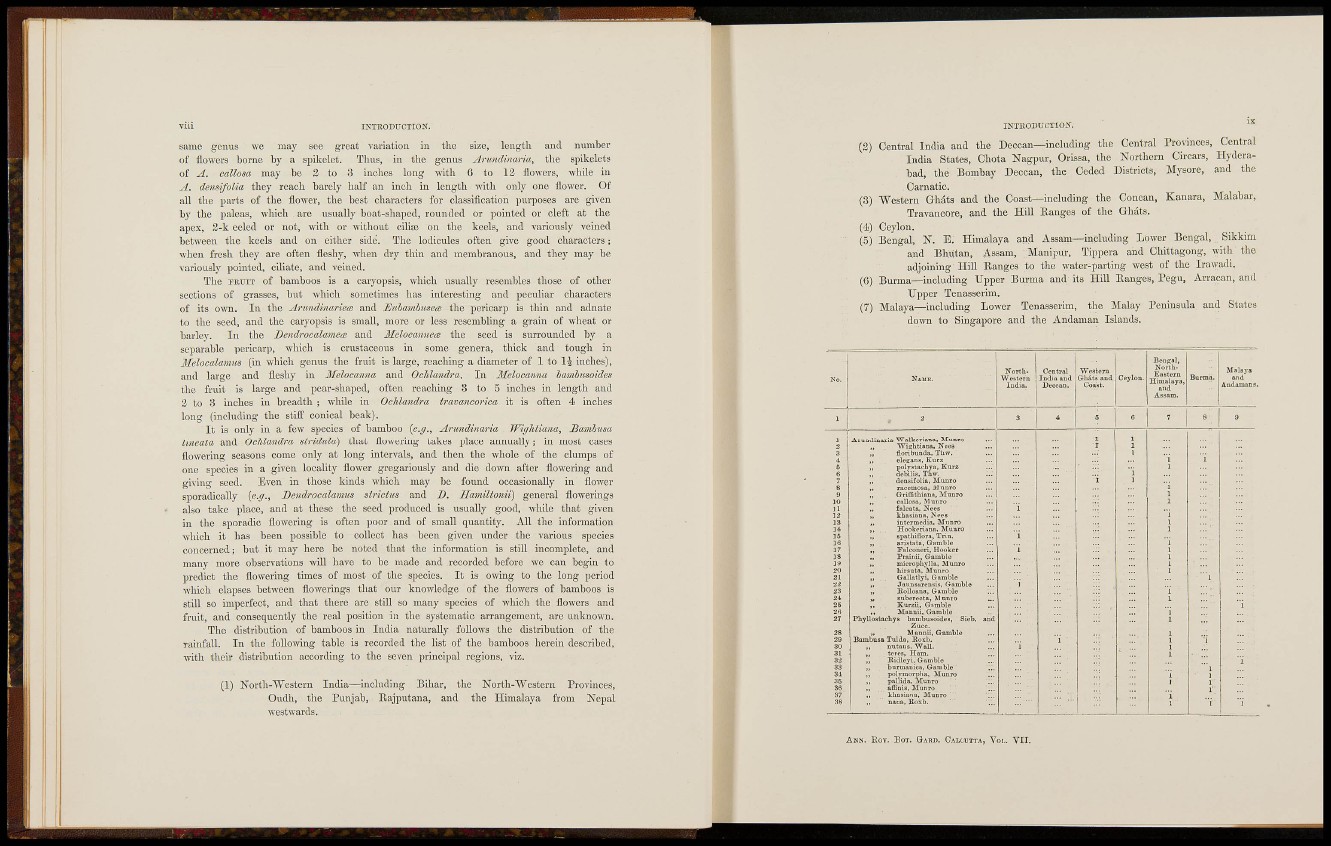
INTEODUCTION.
same genus we may see great variation in the size, length and number
of flowers borne by a spikelet. Thus, in the genus Jrundinaria, the
of J . callosa may be 2 to 3 inches long with 0 to 12 flowers, while in
A. demifolia they reach barely half an. inch in length with only one flower. Of
all tlie parts of the flower, the best characters for classification purposes are given
"by the paleas, which are usually boat-shaped, rounded or pointed or cleft at the
apex, 2-k eeled or not, with or without cilias on the keels, and variously veined
between the keels and on either side. The lodicules often give good characters;
when fresh they are often fleshy, when dry thin and membranous, and they may be
variously pointed, ciliate, and veined.
The liiuiT of bamboos is a caryopsis, which usually resembles those of other
sections of grasses, but which sometimes has interesting and peculiar characters
of its own. In the Anrndinanem and 3iibmnhmea2 the pericarp is thin and adnate
to the seed, and the caryopsis is small, more or less resembhng a grain of wheat or
barley. In the Bendrocalamea and lidocannem the seed is surrounded by a
separable pericarp, which is crustaceous in some genera, thick and tough in
Melocalmnm (in which genus the fruit is large, reaching a diameter of 1 to l i inches),
and large and fleshy in Melocanna and OcJilandra. In Melocanna hamhisoides
the fruit is large and pear-shaped, often reaching 3 to 5 inches in length and
2 to 3 inches in breadth ; wliile in Ocldandra travancorica it is often 4! inches
long (including the stiff conical beak).
I t is only in a few species of bamboo [e.g., Arimd/inaria Wightiana, JBamhisa
Uneaia and Ochlandra stridula) that flowering takes place annually; in most cases
flowering seasons come only at long intervals, and then the whole of the clamps of
one species in a given locality flower gregariously and die down after flowering and
giving seed. Even in those kinds which may be found occasionally in flower
sporadically {e.g., Bendrocalamus strictiis and B. Hamiltonii) general flowerings
also take place, and at these the seed produced is usually good, while that given,
in the sporadic flowering is often poor and of small quantity. AIL the information
which it has been possible to collect has been given under the various species
concerned; but it may here be noted that the information is still incomplete, and
many more observations will have to be made and recorded before we can begin to
predict the flowering tunes of most of the species. It is owing to the long period
which elapses between flowerings that our knowledge of the flowers of bamboos is
still so imperfect, and that there are still so many species of which the flowers and
fruit, and consequently the real position in the systematic arrangement, are unknown.
The distribution of bamboos in India, naturally follows the distribution of the
rainfall. In the following table is recorded the list of the bamboos herein described,
with then* distribution according to the seven principal regions, viz.
(1) North-Western India—including Bihar, the North-Western Provinces,
Oudh, the Punjab, Hajputana, and the Himalaya from Nepal
westwards.
INTRODUCTION ^^
(3) Central India and the Beccan—including the Central Pro^ances, Central
India States, Chota Nagpur, Orissa, the Northern Circars, Hyderabad,
the Bombay Deccan, the Ceded Districts, Mysore, and the
Carnatic.
(3) Western Ghats and the Coast—including the Concan, Kanara, Malabar,
Travancore, and the Hill Eanges of the Ghats.
(4) Ceylon.
(5) Bengal, N. E. Himalaya and Assam—including Lower Bengal,. Sikkim
and Bhutan, Assam, Manipur, Tippera and Chittagong, with the
adjoining HiH Banges to the water-parting west of the Irawadi.
(6) Burma—including Upper Burma and its Hill Ranges, Pegu, Arracan, and
Upper Tenasserim.
(7) Malaya—including Lower Tenassermi, the Malay Peninsula and States
down to Singapore and the Andaman Islands.
Bensal,
North- Central Western Nortli-
Eastern
Himalaya,
^and
Malaya
No, NAME. Western
India,
India and
Deccan,
Gliáts and
Coast,
Ceylon.
Burma. and
Andaman 9.
1 2 3 4 3 6 7 S 9
1 Arnndinaria Walken'ftna, Munro 1 1
2 „ WightiaDa, Nee 8 I 1
3 „ floribunda, Tbw. 1
„ elegans, Kurz 1
6
6
„ polystachya, Kurz
deb'ills, TU. "i
7
8
9
densifolia, Munro
„ racemosa, Munro
„ GriffitMana, Munro
"i 1
]0 „ callosa, .Munro
}1 „ falcata, Nees i
:2 kbasiana, Kees
JS „ intermedia, Munro
14
,, Hookeriana, Munro
15
„ spatliiflora, Trin.
16
„ aristata. Gamble
"i
17 „ Falcoaeri, Hooker i
18 „ Prainii, Gamble
„ microphylla, Munro
20 hirauttt, Munro
21 „ Gallatlyi, Gamble
•¿2
23
„ Jaiinaarensis, Gamble
„ EoUoana, Gamble
24 „ suberecta, Mnnio
26
„ Zurzii, Gamble 2ß ,, Munnii. Gamble
1 27 PhyUostachys bambusoides, Sieb, and
Zuco.
28 Mannii, Gamble
29
30
Bambusa Tulda, Eosb.
„ nutans. Wall. "i "Í i
31 „ teres, Hain.
32 Eidleyi, Gamble
„ bnrmanica. Gamble .;, 1
84 „ polymorph a, Munro
HS pallida, Munro
36 „ aiBnis, Munro
37
38
„ kliasiaiia, Munro
„ nana, Eosb. "i
A N N . ROY. BOT. GAUD. CALCDTTA, VOL. V I I.